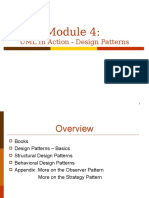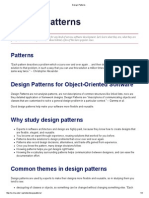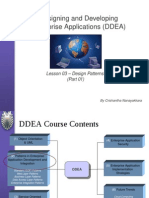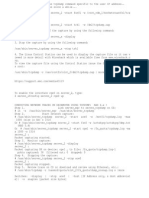0 ratings0% found this document useful (0 votes)
31 viewsPattern Tutorial
This document provides an overview of design patterns, describing their purpose and categories. It then summarizes four specific patterns - Composite, Observer, Strategy, and Singleton - detailing their intent, participants, examples, and relationships between classes in each pattern.
Uploaded by
walygetgroupCopyright
© Attribution Non-Commercial (BY-NC)
We take content rights seriously. If you suspect this is your content, claim it here.
Available Formats
Download as DOC, PDF, TXT or read online on Scribd
0 ratings0% found this document useful (0 votes)
31 viewsPattern Tutorial
This document provides an overview of design patterns, describing their purpose and categories. It then summarizes four specific patterns - Composite, Observer, Strategy, and Singleton - detailing their intent, participants, examples, and relationships between classes in each pattern.
Uploaded by
walygetgroupCopyright
© Attribution Non-Commercial (BY-NC)
We take content rights seriously. If you suspect this is your content, claim it here.
Available Formats
Download as DOC, PDF, TXT or read online on Scribd
You are on page 1/ 3
A Design Pattern Tutorial
Design Patterns document recurring solutions to recurring problems in object-oriented
software design. They are mined from successful object oriented design.
Three Categories of Design Patterns have been found to recur:
• Creational Patterns: Are concerned with object creation (how to organize code
that creates objects)
• Structural Patterns: Deal with composition of classes and objects (how to
organize objects)
• Behavioral Patterns: Characterize ways in which classes and objects interact and
distribute responsibility (how to organize code)
Creational Patterns Structural Patterns Behavioral Patterns
• Abstract
Factory
• Builder
• Factory Method
• Prototype
• Singleton
• Adapter
• Bridge
• Composite
• Decorator
• Facade
• Flyweight
• Proxy
• Chain of
Responsibility
• Command
• Interpreter
• Iterator
• Mediator
• Memento
• Observer
• State
• Strategy
• Template Method
• Visitor
The next few pages will describe and refresh your knowledge of four patterns relevant to
this study. They tell you the intent, purpose, participants, give an analogy and a
mnemonic to each pattern.
• The intent tells you what problem the pattern is trying to address.
• The purpose is why we do it.
• Participants tell you classes and their roles
• Analogy to a something known
• Mnemonic is a short description of the pattern to remember it easily.
DpTut-2 of 5
Description of the Composite Pattern
Category Structural Pattern
Intent • Enable to assemble complex objects out of primitive
objects.
• Compose objects into tree structures to represent partwhole
hierarchies.
Purpose Recursive composition by coupling the aggregate class to a
common abstraction
Participants /
Roles
Component, Composite, Leaf
Analogy Arithmetic expression
Mnemonic Recursive composition
UML Diagram Template
• Child management methods should normally be defined in the Composite class.
An Example Using the Composite Pattern
• The role of ArithmeticExpression is that of Component.
• The role of CompositeOperand is that of Composite
• The role of NumericOperand is that of a Leaf (since it has no children)
DpTut-3 of 5
Description of the Observer Pattern
Category Behavioral Pattern
Intent Define a one-to-many dependency between objects so that when
one object changes state, all its dependents are notified and
updated automatically.
Purpose Decouple independent sender(model) from dependent receivers
(views)
Participants /
Roles
Subject, Observer, Concrete Subject, Concrete Observer
Analogy Auctioneer and bidders
Mnemonic Decouple dependent “views” from the independent subject
UML Diagram Template
• Define an object that is the "keeper" of the data model and/or business logic (the
Subject).
• Delegate all "view" functionality to decoupled and distinct Observer objects.
• Observers register themselves with the Subject as they are created.
• Whenever the Subject changes, it broadcasts to all registered Observers that it has
changed, and each Observer queries the Subject for that subset of the Subject's
state that it is responsible for monitoring.
An Example Using the Observer Pattern
• The role of Subject is that of Subject (they just happen to have the same name)
• The role of View is that of Observer
• GraphicalView and TabularView are Concrete Observers
DpTut-4 of 5
Description of the Strategy Pattern
Category Behavioral Pattern
Intent Define a family of algorithms, encapsulate each one, and make
them interchangeable. Strategy lets the algorithm vary
independently from clients that use it.
Purpose publish interface in a base class, bury implementation in derived
classes
Participants /
Roles
Strategy, Context, ConcreteStrategy
Analogy Number sorting algorithms
Mnemonic Plug-compatible algorithms
UML Diagram Template
• This pattern minimizes coupling between context and the different strategies.
• Why? Because the context is coupled only to the strategy (abstraction)
• The abstraction is captured in the interface (Strategy) but the implementation is
buried in the concrete classes.
An Example Using the Strategy Pattern
• The role of SortImpl is that of Strategy
• The role of Stat is that of Context
• SortBubble and SortShell are Concrete Strategies
DpTut-5 of 5
Description of the Singleton Pattern
Category Creational Pattern
Intent Ensure a class only has one instance, and provide a global point
of access to it.
Purpose Single instance enforcement, lazy initialization, global access
Participants /
Roles
Singleton
Analogy President’s office
Mnemonic Guardian of the single instance
UML Diagram Template
• Make the class of the single instance object responsible for creation, initialization and
access.
• Declare the instance as a private static data member
• Provide a public static member function that encapsulates all initialization code and
provides access to the instance
• Do not use singletons to replace global variables. A singleton is a global variable.
An Example Using the Singleton Pattern
• The role of GlobalResource is that of Singleton
You might also like
- CRM ICWebclient Multilevel CategorizationNo ratings yetCRM ICWebclient Multilevel Categorization4 pages
- Engineering of Software II: Spring 2003No ratings yetEngineering of Software II: Spring 200334 pages
- 6-Software Design Version 1.2 - 2016-12-01No ratings yet6-Software Design Version 1.2 - 2016-12-0129 pages
- Introduction To Design Patterns "Reusable Object Oriented Software Elements"No ratings yetIntroduction To Design Patterns "Reusable Object Oriented Software Elements"22 pages
- Design Patterns: The Power of Reusable SolutionsNo ratings yetDesign Patterns: The Power of Reusable Solutions30 pages
- Lecture 1 Software Design Patterns UpdateNo ratings yetLecture 1 Software Design Patterns Update30 pages
- Design Patterns in Object Oriented Analysis and Design: B. DescriptionNo ratings yetDesign Patterns in Object Oriented Analysis and Design: B. Description4 pages
- Design Patterns: Weslei A. de T. MarinhoNo ratings yetDesign Patterns: Weslei A. de T. Marinho41 pages
- Design Patterns: From Analysis To Implementation By: Et BjectivesNo ratings yetDesign Patterns: From Analysis To Implementation By: Et Bjectives12 pages
- Introduction To Design Patterns: Prabhjeet RekhiNo ratings yetIntroduction To Design Patterns: Prabhjeet Rekhi21 pages
- Design Patterns in Real-Life Object-Oriented SoftwareNo ratings yetDesign Patterns in Real-Life Object-Oriented Software10 pages
- Design Patterns: Dennis Mancl Alcatel-Lucent - Bell LabsNo ratings yetDesign Patterns: Dennis Mancl Alcatel-Lucent - Bell Labs32 pages
- E - 20220426 Security Checks in SAP EarlyWatch Alert, EarlyWatch and GoingLive SessionsNo ratings yetE - 20220426 Security Checks in SAP EarlyWatch Alert, EarlyWatch and GoingLive Sessions12 pages
- Proactive Performance Monitoring Using Metric Extensions and SPANo ratings yetProactive Performance Monitoring Using Metric Extensions and SPA7 pages
- Proforma Usage of Protable Storage Devices (Pen Drive) : TC Code TC Name TC CityNo ratings yetProforma Usage of Protable Storage Devices (Pen Drive) : TC Code TC Name TC City1 page
- Dropboxs Transition From AWS To Custom InfrastructureNo ratings yetDropboxs Transition From AWS To Custom Infrastructure8 pages
- Library Management System - by Zuhi Farzana100% (1)Library Management System - by Zuhi Farzana13 pages
- Chapter 1-Introduction To Object-OrientationNo ratings yetChapter 1-Introduction To Object-Orientation53 pages
- APAC Reservation Newsletter 2022 - 02nd EditionNo ratings yetAPAC Reservation Newsletter 2022 - 02nd Edition7 pages

























































































